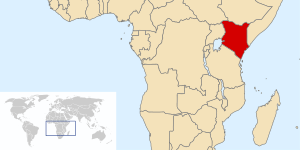Poultry farming in Kenya
Poultry farming in Kenya is a widespread occupation. It is mostly practiced on a small-scale, and predominantly for domestic consumption.

.jpg)
.jpg)
Poultry farming is the raising of domesticated birds such as chickens, turkeys, ducks, and geese, producing meat and eggs.[1] In the event of frequent food shortages and fluctuating prices, some farmers have embraced commercial methods.
Categories
These farmers are classified in several categories:
- 1 – 1000 birds: small scale farmers
- 1001 – 10,000 birds: medium scale farmers
- 10,000+ birds: large scale farmers
The most prevalent animal in Kenya is chicken. Small numbers rear other types of birds. Some farmers specialise on rearing chickens for meat only (broilers), while others focus on egg production (layers); and yet others specialise in rearing the Kienyeji type (indigenous chickens where both cocks and hens live together).
Commercial breeds
Commercial breeds of chickens are:
- Broilers
- Kari Improved Kienyeji Chicken
- Layers
- Kenbro
- Sasso
- Kuroiler
Operations
Broilers
Broilers are reared for meat. In Kenya, broilers are raised both by corporations and individuals. Large scale companies include Kenchic Limited and Brade Gate Poultry Industries. These companies supply meat locally as well as to other countries.
Layers
Large scale layer growers are Kenchic Limited, Muguku Farms, s24 eggs and chicks nyeri Karatina Softkenya Farm Limited and Sigma Supplies.
Kenbro
Kenbro belongs to Kenchick. Kenbro chickens can be reared both for eggs and meat. These chickens are fed for six months before they start laying. Their egg production is lower than that of layers. Those reared for meat take longer to mature than broilers.[2]
See also
References
- Lewis, William M. [from old catalog] (1896). How to raise poultry for pleasure and profit;. New York,: Excelsior publishing house.CS1 maint: extra punctuation (link)
- Omiti, John M. (2009). An overview of the poultry sector and status of Highly Pathogenic Avian Influenza (HPAI) in Kenya Background paper. International Food Policy Research Institute (IFPRI). p. 31. OCLC 690935414.
- Administrator. "Layers Manual". Retrieved 21 December 2014.
- "Traditional Poultry in the World". Retrieved 21 December 2014.
- "Softkenya Farm Limited - Wholesale Supply of chicken eggs in Nairobi Kenya". Softkenya Farm Limited. Retrieved 21 December 2014.